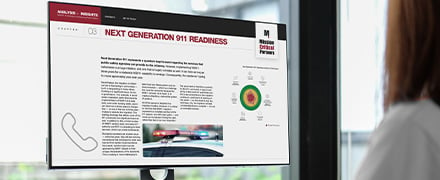MCP's Top Eight Public Safety Predictions for 2019
Posted on January 10, 2019 by Morgan Sava
What trends are expected to disrupt the public safety sector in 2019?
For 911 and emergency response organizations, it has never been more critical to stay ahead of the curve. In this post, Mission Critical Partners' (MCP) subject-matter experts offer their take on the advancements that will have the greatest impact on public safety’s transformation this year.
1. 5G Will Significantly Expand, Opening the Door for Transformative Capabilities that are Limited Today by Wireless Bandwidth.
Dave Sehnert, Director of Innovation and Integration (Twitter: @NG911Consultant)
“5G is expected to expand in 2019 beyond its current limited deployment, and the first wave of smartphones for 5G networks also is expected this year. 5G technology offers speeds that are 10–20 times faster than 4G LTE, and latency is reduced to a few milliseconds. 5G’s impact extends to public safety and other fields that increasingly rely on high-speed connections. Last year, one wireless carrier announced the creation of a 5G First Responder Lab that will serve as an incubator and testing ground for innovative technologies that use 5G and can be deployed for public safety use cases. With 5G, public safety communications finally will benefit from a full spectrum of new and increasingly prevalent technologies, such as sensors, wearables, smartphones, smart buildings, facial-recognition systems and drones, to name a few. The integration of data from these applications into the emergency response ecosystem will create increased situational awareness, reduced response times, and ultimately, the potential for more lives saved.”
2. There Will Be Expanded Use of RMS Data for Social Benefit.
Mike Lyons, Operations Director
“There will be expanded use of records management systems (RMS) data for social benefit programs. Until recently, RMS data has been used primarily for law enforcement purposes. A new trend concerns use of such data to solve tough social problems that manifest themselves through crimes. A good example of this is the opioid epidemic, which places a tremendous burden on law enforcement and the communities that they serve. In these situations, law enforcement data collected and retained in RMS can be leveraged regionally to identify a wide variety of causes and resources that could help battle the problem. Because these systems come from different vendors— and the jurisdictions that use them are often challenged with resource limitations—an objective third party is needed to aggregate the data, provide consulting services, and organize plans for execution and problem resolution.”
3. The Role of Public Alert and Notification Tools Will Need Re-examination.
Gordon Vanauken, Senior Technology Specialist
“Public safety will need to re-examine the role of public alert and notification tools to better protect the public. Emergency alert systems have provided critical alerts to the public for more than a century, but they came under the spotlight after a false missile alert sent thousands of Hawaii residents into a panic early in 2018. While these systems are important tools in every public safety or emergency management agency’s toolkit, what’s equally important is how state, local and federal authorities plan and coordinate with technical, operational and public information staff to develop the best solution for their jurisdictions.”
4. Public Safety’s Acceptance of Cloud-Based Applications and Services Will Accelerate.
“Public safety’s acceptance of cloud-based applications and services will accelerate in 2019. Many in the industry are starting to see cloud-based public safety companies start to disrupt the industry with their solutions. The industry’s adoption of these technologies—in particular those that leverage public-safety-grade, cloud-based services—will increase. Not only are more of these offerings becoming available in the market, several have been proven in test cases. This cloud-based model shifts costs to an ongoing operational expense, making it easier to budget because it eliminates most capital costs. In addition, cloud-based solutions provide resiliency and backup options, enhancing security and ease of maintenance for public safety agencies.”
5. Public Safety Will Continue to Be Challenged by Severe Weather and Natural Disaster Incidents, As Well As Cybersecurity Incidents and ‘Sunny-Day’ Outages.
John Chiaramonte, President, Consulting Services (Twitter: @jchiaramonte)
“Public safety will continue to feel the effects of severe hurricanes, wildfires, and other natural disasters and the sustained, cumulative effects that strain public safety response will intensify in 2019, affecting the ability of emergency call centers to answer 911 calls in a timely manner and the ability for first responders to perform life-saving rescues. Even more unpredictable and perhaps more distressing is that so-called “sunny-day” outages will continue to increase in impact and frequency. The biggest threat to today’s emergency call centers is service disruptions caused mostly by human error, and not weather-related incidents. These outages are a direct result of the nation’s aging and fragile 911 infrastructure—most of the 911 community relies on 25–30-year-old legacy selective routers for distribution of 911 calls—single points of failure in their mission-critical enterprise, and a lack of connectivity diversity.”
6. A Federal Grant Program Will Create the Potential for a FirstNet-Like Funding Mechanism Through Congress, Paving the Way for NG911 and NG911 2.0.
Jackie Mines, Senior Project Manager
“A new $109-million-dollar grant program intended to help drive the 911 community’s transition to Next Generation 911 (NG911)—the National 911 Grant Program—will roll out in 2019. This FirstNet–like grant program will advance implementation of NG911 services and improve the technology and operation of the nation’s 911 system for initiatives such as implementation of IP-based emergency services networks (ESInets) and applications, geographic information system (GIS) data enhancements, and training for 911 center personnel and first responders on NG911. The public safety community also will see the next phase of NG911—NG911 2.0—as several states begin investing in the second iteration of their statewide ESInets.”
7. Staffing Challenges Will Force PSAPs to Start Thinking Differently.
Bonnie Maney, Vice President, Director of Facilities/Operations (Twitter: @BonnieManey)
“Staffing continues to be a nationwide epidemic for today’s 911 centers that is affecting even the most cutting-edge PSAPs in the country. The situation is worsening, driven by an economy that has picked up steam over the past year as less-stressful, better-paying jobs are in abundance, and telecommunicators are flocking to them. Creative thinking will be required for the 911 community to overcome this never-ending struggle, and PSAPs will need to think far beyond filling the seats. Shifting the approach from “staffing” to “workforce optimization” will get the right people in the right seats and keep them there for the long haul.”
8. Great Advancements in the Use of Public Safety Data to Improve Emergency Response Will Occur.
John Chiaramonte, President, Consulting Services (Twitter: @jchiaramonte)
“The sheer amount of data being created in and around the public safety community is enormous, and overwhelming to say the least. Today, very little of that data is actionable or used to any benefit. 2019 will see examples of how 911 telecommunicators and first responders will acquire, analyze, transform and distribute new and existing datasets that will decrease response times, increase responder safety, and translate into more lives saved.”
2019 will definitely be an exciting and transformative year for public safety; be prepared for some major transformations and new entrants into the market.
Watch our live webinar on this topic, to be held on January 31, “MCP’s Top 11 Strategic Public Safety Trends for 2019.” You’ll hear from MCP experts first hand on these and other significant technology and operations trends that we feel will set the stage for public safety over the next three to five years.
If you would like to receive further insights, sign up for “MCP Insights,” our monthly newsletter.
Topics: Next Generation 911 Networks, Operations, Staffing, Technology, Public Safety Technology, Wireless Communications








